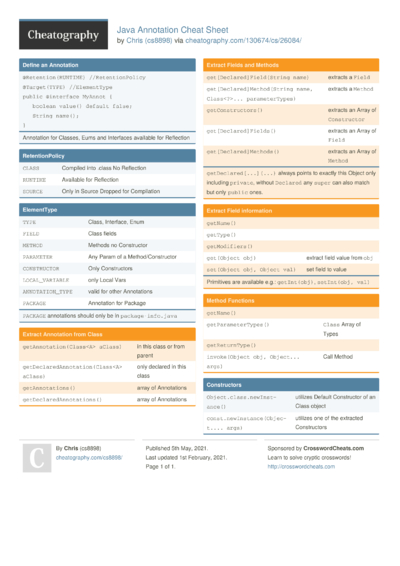

Security Spring Security’s web security support and provides the Spring MVC Spring Security’s global method that defines a method-level security that indicates the method is to be pre-authorized before that indicates the method is to be post-authorized after used to specify the roles allowed to access a method.
Java spring annotations cheat sheet code#
a web for mapping web requests onto methods in request-handling classes with flexible method for mapping HTTP GET requests onto specific handler for mapping HTTP POST requests onto specific handler for mapping HTTP PUT requests onto specific handler for mapping HTTP DELETE requests onto specific handler which indicates that a method parameter should be bound to a URI template which indicates that a method parameter should be bound to a web request indicating a method parameter should be bound to the body of the web indicating a method return value should be bound to the web response that marks a method or exception class with the status code and reason that should be returned.ĭata that a class is an that an annotated class is a “”Repository””, originally defined by Domain-Driven Design (Evans, 2003) as “”a mechanism for encapsulating storage, retrieval, and search behavior which emulates a collection of that an annotated class is a “”Service””, originally defined by Domain-Driven Design (Evans, 2003) as “”an operation offered as an interface that stands alone in the model, with no encapsulated that can be applied to classes and methods to indicate that they should be run in a transactional a constructor, field, or setter method as to be autowired by Spring’s dependency injection used to differentiate beans of the same type. Web that a class is a “”Controller”” (e.g. Table of ContentsĬonfiguration the main class of a Spring Boot that a class declares one or more methods and may be processed by the Spring container to generate bean definitions and service requests for those beans at Spring Boot’s auto-configuration component scanning directives for use with providing a convenient and declarative mechanism for adding a PropertySource to Spring’s at the field or method/constructor parameter level that indicates a default value expression for the affected argument. The annotations are grouped by theme and presented in a table format. This cheat sheet provides an overview of the most commonly used Spring Boot annotations. You can use this annotation to configure your application without hardcoding values in your code. This annotation is used to inject values from a properties file or environment variable into a class.When you use this annotation, Spring will automatically create an instance of the dependency and inject it into the class. This annotation is used to inject dependencies into a class.

You can specify the HTTP method (GET, POST, etc.) and the URL path. This annotation is used to map a URL to a method in a controller.It tells Spring that this class will handle HTTP requests and responses. It combines three other annotations: and This annotation is used to mark a class as a REST controller. This annotation is used to mark the main class of your Spring Boot application.Here are some of the most commonly used annotations: There are many annotations available in Spring Boot, each with its own purpose. Annotations are a way to add metadata to your code that can be used by the Spring framework to configure your application. One of the key features of Spring Boot is its support for annotations. It provides a lot of features that make it easy to develop and deploy applications quickly.

Spring Boot is a popular framework for building Java applications.


 0 kommentar(er)
0 kommentar(er)
